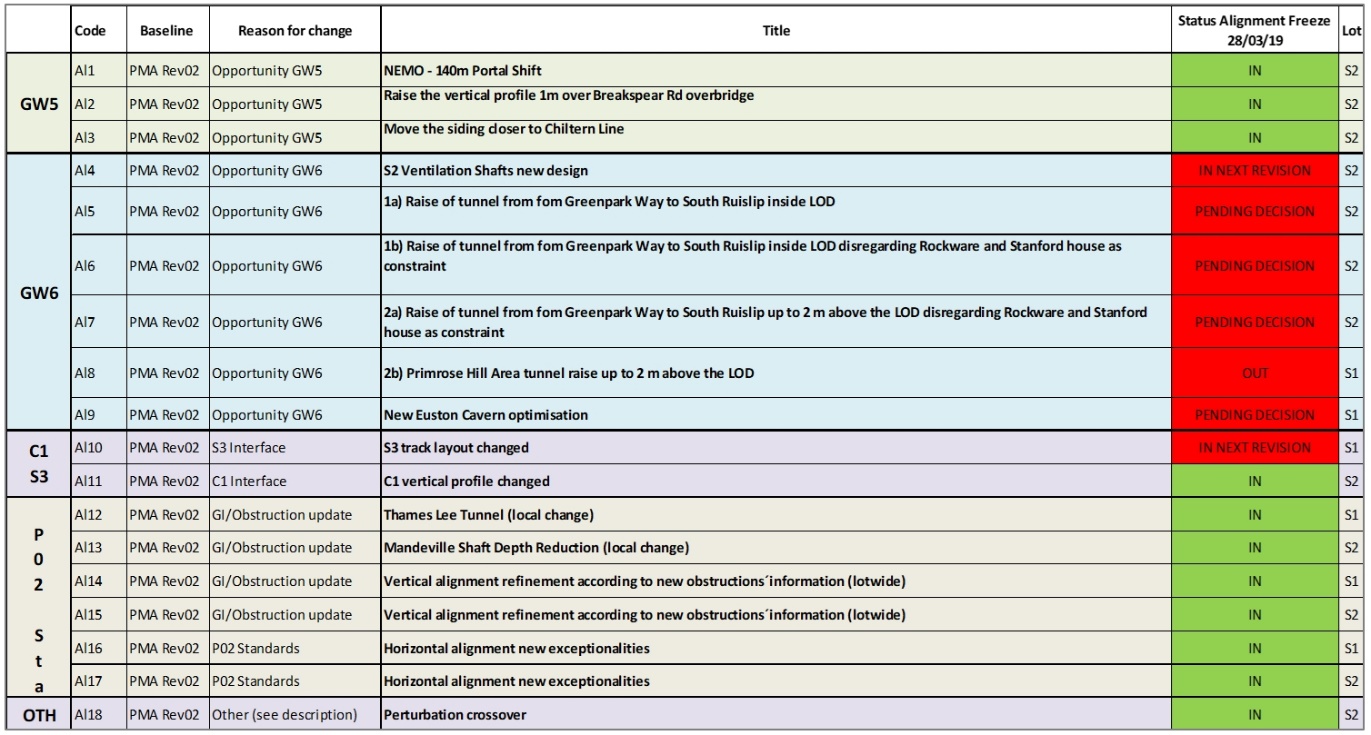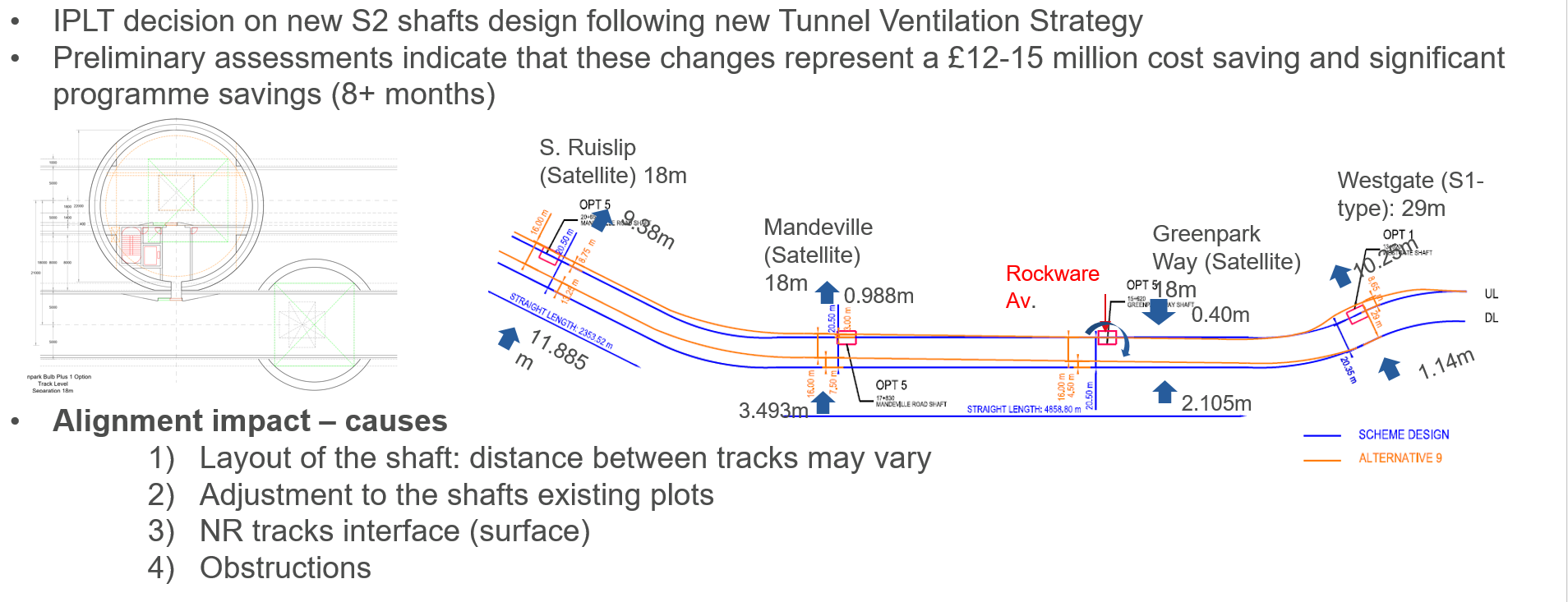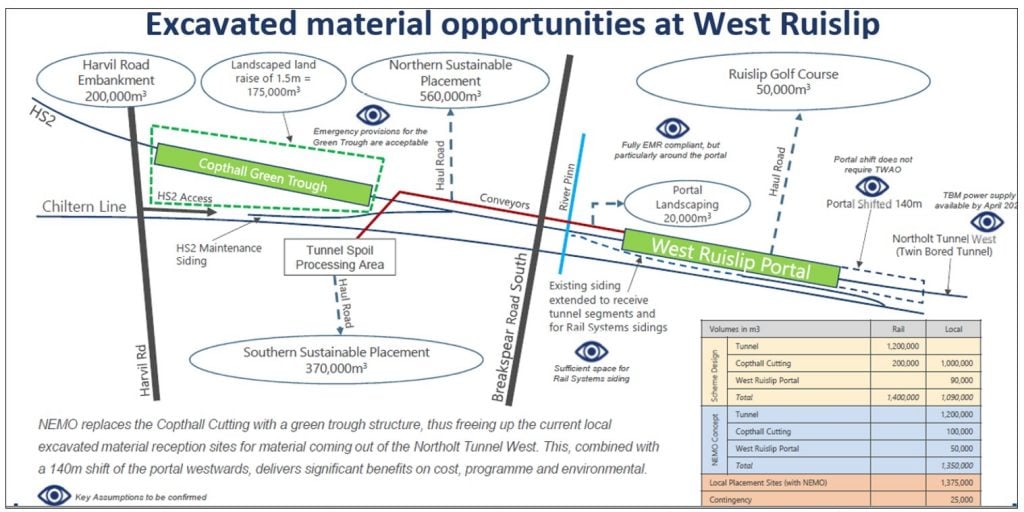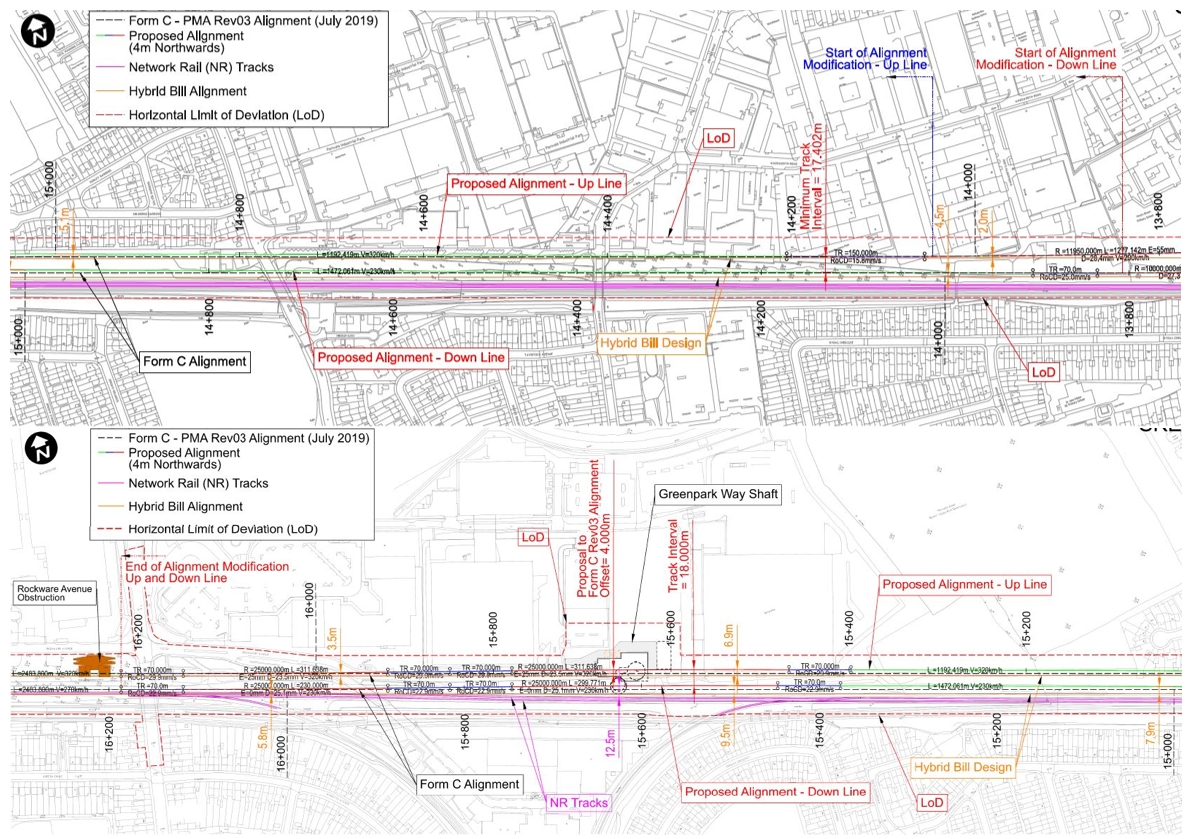HS2 track alignment change process through collaboration
In every high-speed railway project, the track alignment is one of the most, if not the most, critical element of design. The alignment is the basis that the rest of the civil works design is based on, with any change potentially having a significant knock-on impact.
Hence the creation of a holistic contract-wide change control process was prioritised early on enabling a flexible and technically-sound implementation of opportunities, interfaces and new standards. It has constituted a step change on how collaboration between design, construction teams and client can successfully work.
Alignment determines, in the first instance, the construction feasibility and affordability; mass haul diagrams, tunnel length and ground conditions the structures will have to face, impact on third parties, adjacent contracts and obstructions. More importantly, the whole life cycle performance of the infrastructure: operations, maintenance, whole-life cost and carbon, emerge from and are shaped by the alignment design. This reinforces the need to successfully and collaboratively address measures that take into account all stakeholders at the early stages.
This paper covers how opportunities, interfaces with adjacent contracts, innovation, new standards implementation and how HS2’s interfaces with third parties were addressed and processed in a fully collaborative environment.
Context
This paper focuses on the southern section of High Speed Two (HS2) Phase One – Lots S1 and S2 (Area South) –including the Northolt Tunnels and the Euston Tunnel and Approaches, being delivered by the SCS Integrated Project Team (IPT).
The Project Master Alignment (PMA) is the HS2 alignment that integrates all new developments in an assured manner and is managed and controlled by HS2 Ltd, the ultimate owner of the infrastructure. This ensures a single source of truth and the coordination of all contracts and design packages of the HS2 Project. Every change proposed by any of the intervening parties then follows the Route Development Procedure and is finally consolidated in a Form C. Following its revision and approval, the proposal is integrated in an updated version of the HS2 PMA and shared back with the different contract representatives.
A consolidated PMA was provided to all the Main Works Civils Contractors at scheme design. This combined all component parts of the alignment for all lots within the HS2 Project and was the initial reference to work from.
Design House (DH) (part of the SCS IPT) mobilised a Route Civils team to support SCS on the alignment development for Lots S1 and S2. The first task they developed, after thoroughly reviewing the reference design, was to undertake value engineering, initiated in September 2017. Construction teams and design disciplines participated in the identification and development of new opportunities to bring value to the project.
Following the optioneering process, and once the sifting outcomes were confirmed for all options under assessment, a new alignment was developed and it informed all the assets along the route.
HS2 actively participated in the process, denoting a change on how engineering can be undertaken, with a fully collaborative approach. The final product of the aforementioned process was a first version of the alignment Form C[1],[2](July 2018), requesting a change to consolidate the value engineering exercise.
Scheme Design progressed based on the newly created Form C[1],[2] till, once the scheme was finished in Autumn 2018, a new scenario loomed where further opportunities were identified prior to progress to the detail design and construction stage. Alignment was a key to realise those opportunities. The challenge was – how to speed up a process that previously took eighteen months, now with only a third of that period available, and not to jeopardise the construction programme.
A collaborative approach was then promoted, and an integrated working group composed of HS2 alignment representatives, SCS Design Management and DH was created. This group jointly develop solutions proactively, setting up fortnightly control sessions to develop the Alignment Options Reports[3],[4],[5] and ultimately the final Form C[1],[2] (July 2019) that covered all changes promoted by the Integrated Project Leadership Team (IPLT) and enabled the project to progress fulfilling all parties’ requirements.
From then onwards, and learning from the approach undertaken during 2019, the alignment, typically a rigid element of the design, has been able to rapidly adapt to arising challenges and opportunities, and efficiently take advantage of them when required.
The project currently is based on an updated and consolidated alignment that will be the one that constitutes the basis for the construction and operation of HS2. The timeline of the process is shown in figure 1.

Scheme design – understanding
In order to take advantage of the opportunities an Early Contractor Involvement (ECI) contract could offer, an Integrated Project Team (IPT) (DH, SCS and HS2) started to work together through an optioneering process, initiated in September 2017.
In Figure 2 below, each column represents an asset that underwent an optioneering process itself. Some of the value engineering exercises performed on an asset in isolation had repercussions on the alignment. An example of this cross-impact was the implementation of a central shaft increasing the distance between bores and thus, requiring a horizontal alignment change.
Also in Figure 2, each row represents time, starting with a brainstorming session. A sift was then conducted and with the remaining options an integration workshop was held. The intention of that session was to consolidate the optioneering of the alignment together with the changes that were promoted from the assets individually.

The main ideas generated during the brainstorming period were around various themes which included looking at all vertical and horizontal obstructions to study further options of modifying the alignment in compliance with the HS2 Technical Standards and improve the Euston throat and Northolt tunnel designs as well as minimising the separation between tunnels.
A first sift confirmed compliance and assurance of the solutions brainstormed and discarded the non-compliances. Compliance checks were undertaken as shown in Figure 3, in line with HS2 Route Development Procedure [6].

Alignment was used as an integration tool along the whole scheme, becoming an assurance check process. This integration exercise, conducted jointly by SCS construction, HS2 and DH representatives, enabled the project to progress towards the final sift and finally with the alignment that informed the Scheme Design and was defined in detail in the first alignment Form C [1], [2] issued in Summer 2018.
As a summary, the most relevant alignment changes consolidated during the Scheme Design were:
- Euston Throat – Cavern realignment (S1)
- Reassessment of vertical alignment / obstructions (S1 and S2)
- Minimisation of separation between tunnels (S1 and S2)
- Horizontal alignment changes to accommodate the shafts horizontal fans solution (S1)
Rethinking the scheme design. Active collaboration
Once the Scheme Design was closed, the project progressed into a stage where further opportunities were identified, with the alignment at the core of every decision to make the engineering changes work holistically.
Through critical review of the design assurance process to maximise the benefit of our co-located strategy (same team, same office), a fully interactive approach was undertaken. This approach went a step further compared to the previous phase; An Alignment Working Group (AWG) composed by HS2 alignment representatives, SCS and DH design management was conformed to ensure the main opportunities promoted by the IPLT were assured and progressed.
The main alignment changes within this stage related to the development of new solutions for certain assets. Once a specific opportunity was approved by the IPLT, it was discussed and reviewed by the AWG and then the alignment integrated it if the resolution was favourable. Ultimately, the alignment acted as a final sift of all IPLT promoted opportunities to ensure compliance and its suitability (see Figure 4 below):

The main sources of change during this period were:
- Opportunities (GW5 and GW6, depending on the IPLT identification period).
- Incorporation of changes generated by the adjacent lots (S3 and C1).
- Update to new set of HS2 Standards and implementation of EDC-076 (Engineering Design Change) specifically including the consideration of “passive provision for a perturbation crossover between West Ruislip Portal and Colne Valley Viaduct”.
- GI / Obstructions improvements and overall risk reduction.

Once the review process took place, Alignment Options Reports[3], [4], [5] were developed to collect all decisions made to date and informed the creation of a revised Form C [1], [2] that was subject of HS2 subject matter experts’ (SME) review and acceptance.
To enhance the communication with other HS2’s disciplines not co-located with SCS (operations, maintenance, systems), the AWG presented in May 2019 all the changes under development to seek acceptance and ensure a direct line of communication, streamlining the decision making process and avoiding unexpected surprises once the formal documentation was transmitted to the relevant approval body.
The AWG was a key that enabled an agile and versatile management of the changes improving the way the team had been working during the previous stages by learning from it. It constituted a useful tool that helped the IPLT decisions to be implemented on time ensuring compliance with HS2 standards and the creation of a strong communication strategy across the project.
The Route Development Procedure [6] (RDP) was applied during the process resulting in a Form C [1], [2] by the end of July 2019. See Figure 6.

Some of the main opportunities that were successfully implemented in the period were:
- Increased clearance to Thames Lee Tunnel and Adelaide Ventilation Shaft civil works depth reduction (See Figure 7, where the green line represents the consolidated option).

- New Tunnel Ventilation Strategy Implementation (redesign of S2 Ventilation Shafts) with an alignment impact (see Figure 8).

- New excavated material opportunities, including a Portal Shift, raise of vertical profile and the siding close to the Chiltern Line realignment. See Figure 9.

Final alignment form C
The final alignment Form C [1],[2] of July 2019 (version C03 of the Form C documents [1], [2]) incorporated all track alignment refinements approved by the IPLT as described in the previous section. Since then, this Form C has constituted the basis of the assets civil design for both S1 and S2 HS2 Phase One lots.
This final Form C collates a wide range of documents in order to prove that the track alignment design complies with HS2 Technical Standards applicable to this specific project:
- Schedule of TADS (Technical Standard – Track Alignment Design [7]. Exceptional Values and Non-Compliances, a comparison between the baseline option for the track alignment and the proposed change, based on non-compliant and exceptional values.
- Alignment Design Change Report (ADCR), including a designer’s log with key decisions for the change as well as new risks and assumptions associated with the proposed change. This document records both interdisciplinary and interface consultations including a summary of high-level impacts.
- Designer Geometry Check Sheet and Summary of Changes, where the occurrence of new non-compliant and unavoidable exceptional values is recorded.
- Plan Profile and obstruction drawings, supporting plan and profile drawings which include both the baseline option and proposed track alignment change. A graphic comparison for a better understanding.
- 3D models and the alignment file, the main alignment tools that will be part of the future HS2 PMAs.
These documents are focused on the alignment only but do not compile all aspects related to the change assessment as a whole. That was the starting point of the Alignment Options Reports, which were included in the project to provide a structured and evidenced approach of the changes. Options Reports summarise merits and weaknesses, for all disciplines, of all studied options and against the baseline option as developed and reviewed by the AWG.
Further refinements
That version of the alignment Form C is considered the basis of the civil design since July 2019. Nevertheless, the integrated project team has developed further opportunities to de-risk or improve the scheme when it was feasible. The incorporation of an alignment change at Greenpark Way Ventilation Shaft into the HS2 Project Master Alignment (PMA) is a good example of this.
Greenpark change is the result of an engagement process carried out on the development of different opportunities where design, construction and operation & maintenance disciplines were involved following the successful example set by the AWG in 2019.
The design change process finalised with a Joint Engineering change Panel (ECP), session where the possibility of sifting the alignment by 4m northwards was put forward in order to reduce the risk on the operation of the Network Rail Chiltern lines, running adjacent and parallel to the south of the HS2 alignment.
In addition to that, clear benefits in terms of health and safety, temporary works rationalisation, drilling and ground movement reduction were the main drivers for the ECP to support this alignment refinement.
The benefits of the change were clear but its integration in a new alignment iteration was challenging. With on-going detail design for most of the assets underway along the S1 and S2 scheme, the alignment had to be modified mitigating knock-on impacts on other elements of the design and complying with HS2 Technical Standards. See Figure 10.

Greenpark alignment change was carried out with the support of HS2 specialists following the Route Development Procedure [6]. This provided an informed decision on the alignment design option the project should progress with. As a result of that collaborative work, the initial alignment for Greenpark underwent further refinements until a final proposal was agreed by all parties. The result was the Greenpark Alignment Form C [2].
The newest alignment Form C was backed by a new Alignment Options Report [8]. In that case, the report collated all decisions made related to the new alignment change.
The ECP meeting gave all parties involved the confidence that a satisfactory design could be achieved. A collaborative exercise carried out by a multidisciplinary team that has ended up in an improvement of the former design.
Conclusions and lessons learnt
The main focus of this paper is not to demonstrate the thorough engineering and technical work undertaken behind the scenes, but an approach to collaboration that if properly managed could bring lean and integrated management practices to future projects.
It is all about a learning curve. It has been presented how SCS and DH started to work together during the Scheme Design, how a single team was set in motion sharing a common vision and objectives, which was continued during the opportunities implementation stage later on. Finally, a further demonstration of the effective collaboration is the direct implementation of a change at Greenpark Ventilation Shaft. A task that could have taken a long time at the early stages of the contract was performed in a short period of time following an assured, transparent and consistent process.
Throughout the process we have learned how to work collaboratively in an ECI environment, with a seamless design, construction and HS2/operations integrated project team sharing objectives and actively participating in a process that has been beneficial for the project as a whole.
Collaboration is the key in engineering of the future, we are stronger together, and by bringing out the best from each and every discipline and organisation, with a proactive attitude and an integrated approach, future engineering projects cannot be but successful leaving an enduring legacy for generations to come.
Acknowledgements
Bryan Todhunter (HS2), for his understanding and support throughout the process, ensuring HS2´s visibility and contribution to the process.
Carlos Gomez Milder (DH), for his support and productive participation in the alignment evolution from day one on behalf of DH leadership team.
Tom Beales-Ferguson (DH), for his continuous support to the Route Civils team ensuring impact on third party assets was at the core of every decision and for his coordination role, key to ensure consistency between the alignment and GMAs (Ground Movement Assessments) development.
References
[1] 1MC03-SCJ-RT-FRM-S001-000002, Alignment Form C – Alignment Design Change Report (ADCR) – S1.
[2] 1MC04-SCJ-RT-FRM-S002-000002, Alignment Form C – Alignment Design Change Report (ADCR) – S2.
[3] 1MC03-SCJ-RT-REP-S001-000004, Alignment Options Report S1.
[4] 1MC04-SCJ_SDH-RT-REP-S002-000001, Alignment Options Report – Northolt Tunnels S2.
[5] 1MC04-SCJ_SDH-RT-REP-SS05_SL07-000001, Alignment Options Report – West Ruislip Area Structures S2.
[6] HS2-HS2-SA-PRO-000-000007, Route Development Procedure.
[7] HS2-HS2-RT-STD-000-000001, Technical Standard – Track Alignment Design Standard.
[8] 1MC04-SCJ_SDH-RT-REP-SS05_SL06-000001, Alignment Option Report – Greenpark Way Vent Shaft S2.
Peer review
- Vara Suntharalingam, Civil Engineering DirectorHS2 Ltd

